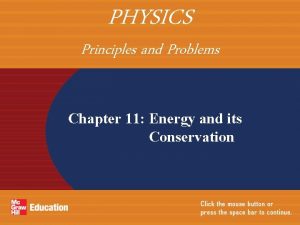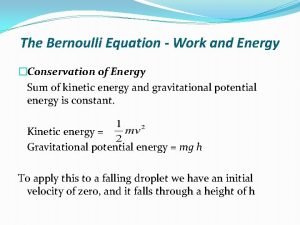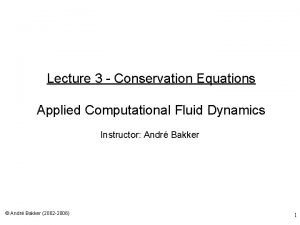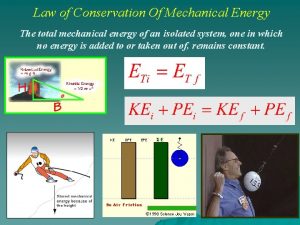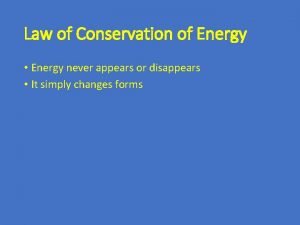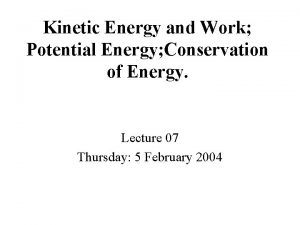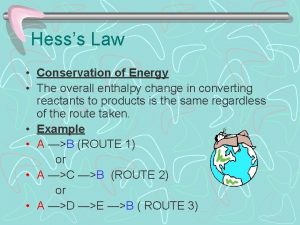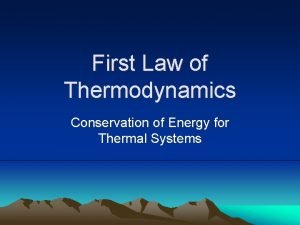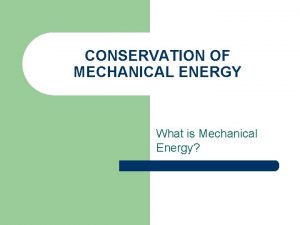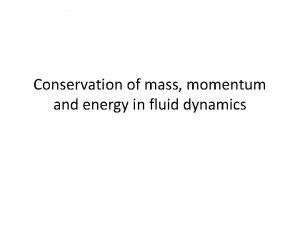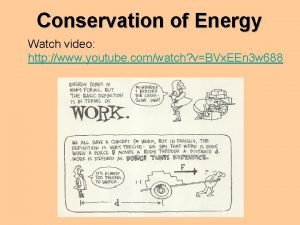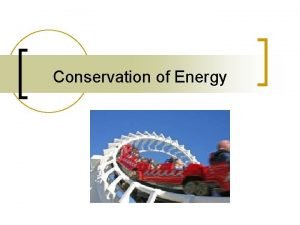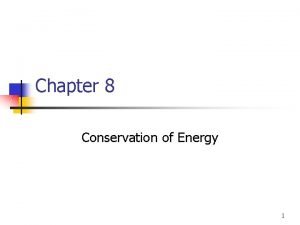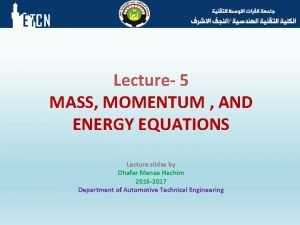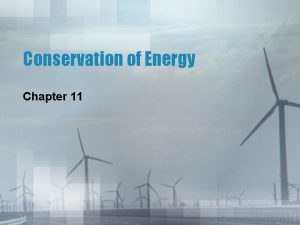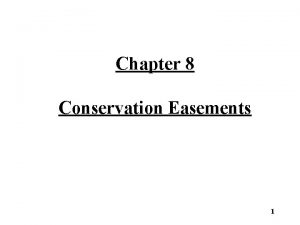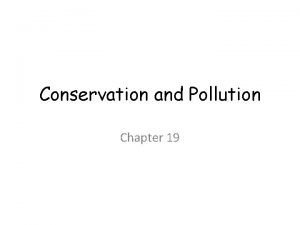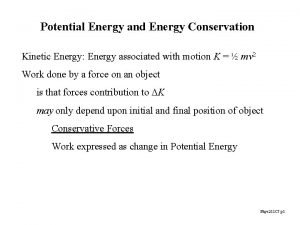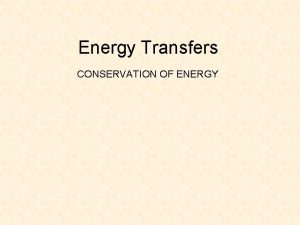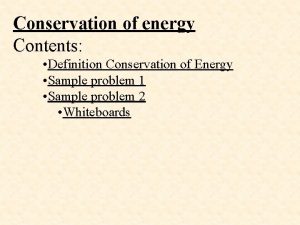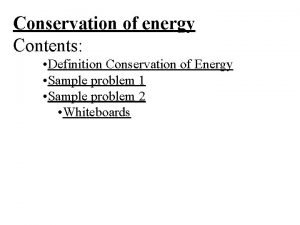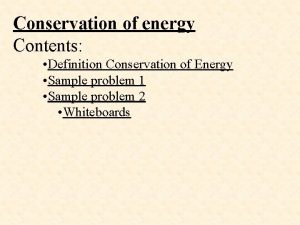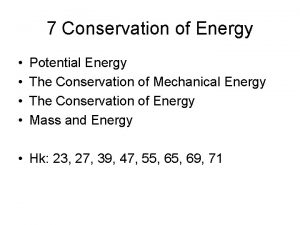Conservation of Energy Chapter 11 Conservation of Energy























- Slides: 23

Conservation of Energy Chapter 11

Conservation of Energy • The Law of Conservation of Energy simply states that: 1. The energy of a system is constant. 2. Energy cannot be created nor destroyed. 3. Energy can only change form (e. g. electrical to mechanical to potential, etc). – True for any system with no external forces. ET = KE + PE + Q – – – KE = Kinetic Energy PE = Potential Energy Q = Internal Energy [kinetic energy due to the motion of molecules (translational, rotational, vibrational)]

Conservation of Energy Mechanical Kinetic Nonmechanical Potential Gravitational Elastic

Conservation of Mechanical Energy • Mechanical Energy: – If Internal Energy is ignored: ME = KE + PE • PE could be a combination of gravitational and elastic potential energy, or any other form of potential energy. – The equation implies that the mechanical energy of a system is always constant. • If the Potential Energy is at a maximum, then the system will have no Kinetic Energy. • If the Kinetic Energy is at a maximum, then the system will not have any Potential Energy.

Conservation of Mechanical Energy ME = KE + PE KEinitial + PEinitial = KEfinal + PEfinal

Example 4: • A student with a mass of 55 kg goes down a frictionless slide that is 3 meters high. What is the student’s speed at the bottom of the slide? KEinitial + PEinitial = KEfinal + PEfinal • • KEinitial = 0 because v is 0 at top of slide. PEinitial = mgh KEfinal = ½ mv 2 PEfinal = 0 at bottom of slide. – Therefore: • • PEinitial = KEfinal mgh = ½ mv 2 v = √ 2 gh V = (2)(9. 81 m/s 2)(3 m) = 7. 67 m/s

Example 5: • A student with a mass of 55 kg goes down a non-frictionless slide that is 3 meters high. – Compared to a frictionless slide the student’s speed will be: a. the same. b. less than. c. more than. • Why? • Because energy is lost to the environment in the form of heat (Q) due to friction.

Example 5 (cont. ) • Does this example reflect conservation of mechanical energy? • No, because of friction. • Is the law of conservation of energy violated? – No, some of the “mechanical” energy is lost to the environment in the form of heat.

Energy of Collisions • While momentum is conserved in all collisions, mechanical energy may not. – Elastic Collisions: Collisions where the kinetic energy both before and after are the same. – Inelastic Collisions: Collisions where the kinetic energy after a collision is less than before. • If energy is lost, where does it go? • Thermal energy, sound.

Collisions • Two types – Elastic collisions – objects may deform but after the collision end up unchanged • Objects separate after the collision • Example: Billiard balls • Kinetic energy is conserved (no loss to internal energy or heat) – Inelastic collisions – objects permanently deform and / or stick together after collision • Kinetic energy is transformed into internal energy or heat • Examples: Spitballs, railroad cars, automobile accident

Example 4 • Cart A approaches cart B, which is initially at rest, with an initial velocity of 30 m/s. After the collision, cart A stops and cart B continues on with what velocity? Cart A has a mass of 50 kg while cart B has a mass of 100 kg. A B

Diagram the Problem A B Before Collision: p. A 1 = mv. A 1 p. B 1 = mv. B 1 = 0 After Collision: p. A 2 = mv. A 2 = 0 p. B 2 = mv. B 2

Solve the Problem • pbefore = pafter 0 0 • m. Av. A 1 + m. Bv. B 1 = m. Av. A 2 + m. Bv. B 2 • m. Av. A 1 = m. Bv. B 2 • (50 kg)(30 m/s) = (100 kg)(v. B 2) • v. B 2 = 15 m/s • Is kinetic energy conserved? • KEi =? KEf

Solve the Problem • m. A = 50 kg v. A 1 = 30 m/s • m. B = 100 kg v. B 2 = 15 m/s • • Is kinetic energy conserved? KEi =? KEf KEi = Sum(½ mivi 2) KEf = Sum(½ mfvf 2)

Example 5 Per 7 • Cart A approaches cart B, which is initially at rest, with an initial velocity of 30 m/s. After the collision, cart A and cart B continue on together with what velocity? Cart A has a mass of 50 kg while cart B has a mass of 100 kg. A B

Diagram the Problem A B Before Collision: p. A 1 = mv. A 1 p. B 1 = mv. B 1 = 0 After Collision: p. A 2 = mv. A 2 p. B 2 = mv. B 2 Note: Since the carts stick together after the collision, v. A 2 = v. B 2 = v 2.

Solve the Problem • pbefore = pafter • m. Av. A 1 + m. Bv. B 1 = m. Av. A 2 + m. Bv. B 2 • m. Av. A 1 = (m. A + m. B)v 0 2 • (50 kg)(30 m/s) = (50 kg + 100 kg)(v 2) • v 2 = 10 m/s • Is kinetic energy conserved? • KEi =? KEf

Key Ideas • Conservation of energy: Energy can be converted from one form to another, but it is always conserved. • In inelastic collisions, some energy will be lost as heat • ET = KE + PE + Q

Key Ideas • Gravitational Potential Energy is the energy that an object has due to its vertical position relative to the Earth’s surface. • Elastic Potential Energy is the energy stored in a spring or other elastic material. • Hooke’s Law: The displacement of a spring from its unstretched position is proportional the force applied. • Conservation of energy: Energy can be converted from one form to another, but it is always conserved.

Simple Harmonic Motion & Springs • Simple Harmonic Motion: – An oscillation around an equilibrium position in which a restoring force is proportional the displacement. – For a spring, the restoring force F = -kx. • The spring is at equilibrium when it is at its relaxed length. • Otherwise, when in tension or compression, a restoring force will exist.

Simple Harmonic Motion & Springs • At maximum displacement (+ x): – The Elastic Potential Energy will be at a maximum – The force will be at a maximum. – The acceleration will be at a maximum. • At equilibrium (x = 0): – The Elastic Potential Energy will be zero – Velocity will be at a maximum. – Kinetic Energy will be at a maximum

Harmonic Motion & The Pendulum • • Pendulum: Consists of a massive object called a bob suspended by a string. Like a spring, pendulums go through simple harmonic motion as follows. T = 2π√l/g Where: » T = period » l = length of pendulum string » g = acceleration of gravity • Note: 1. 2. This formula is true for only small angles of θ. The period of a pendulum is independent of its mass.

Conservation of ME & The Pendulum • In a pendulum, Potential Energy is converted into Kinetic Energy and vise-versa in a continuous repeating pattern. – – • PE = mgh KE = ½ mv 2 MET = PE + KE MET = Constant Note: 1. 2. 3. Maximum kinetic energy is achieved at the lowest point of the pendulum swing. The maximum potential energy is achieved at the top of the swing. When PE is max, KE = 0, and when KE is max, PE = 0.
 Chapter 7 energy conservation of energy
Chapter 7 energy conservation of energy Chapter 11 study guide energy and its conservation answers
Chapter 11 study guide energy and its conservation answers Chapter 11 energy and its conservation answers
Chapter 11 energy and its conservation answers Mechanical energy
Mechanical energy Benoulli equation
Benoulli equation A small child slides down the four frictionless slides
A small child slides down the four frictionless slides Derive the equation of kinetic energy
Derive the equation of kinetic energy Law of conservation of mechanical energy definition
Law of conservation of mechanical energy definition Law of conservation of energy worksheets
Law of conservation of energy worksheets Ki + ui = kf + uf
Ki + ui = kf + uf Principle of conservation of energy
Principle of conservation of energy First law of energy conservation
First law of energy conservation Energy conservation in boiler
Energy conservation in boiler What is the conservation of mechanical energy
What is the conservation of mechanical energy Mass momentum and energy conservation
Mass momentum and energy conservation Energy conservation law
Energy conservation law Conservation of energy youtube
Conservation of energy youtube The law of conservation of energy states that
The law of conservation of energy states that Conservation of mechanical energy
Conservation of mechanical energy Conservation of energy
Conservation of energy What is the conservation of mechanical energy
What is the conservation of mechanical energy Conservation of energy review
Conservation of energy review Energy conversion and conservation
Energy conversion and conservation Conservation of mass momentum and energy equations
Conservation of mass momentum and energy equations

